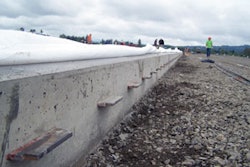For resilient flooring placed on concrete slabs on grade, moisture may cause problems, including delamination of vinyl and re-emulsification of adhesives. This is indisputable.
What is disputed is the source of the water. And as I pointed out in Part 1 of this column (see April/May 2009 Concrete Contractor), attorneys involved in "defect litigation" increasingly rely on standards developed by the flooring industry to lay the blame on concrete slabs and those involved in the design, production and installation of concrete.
Over the years, the flooring industry has written standards, particularly ASTM F710, which appears to make the concrete industry at large responsible and accountable for flooring problems, even though these flooring standards are largely inaccurate and, presumably, irrelevant to the concrete industry.
Ironically, there is more water applied in cleaning resilient flooring than could ever emanate from the concrete slab. Moreover, not all flooring discoloration is caused by moisture. Other major causes of flooring damage include poor surface preparation and installation; debris left on the slab surface; wear and tear; and improper adhesives or their application. Concrete that meets the project's material specifications is satisfactory, considering its long and successful history.
There are few projects in which moisture rising through the slab damages resilient flooring, though it's often alleged in defect litigation.
Why doesn't F710 address these items more thoroughly? Because the standards were advanced by flooring industry representatives. These standards are not based on the specified properties of concrete or the proportions of its various ingredients. Nor do they defer to project plans or specifications. Yet the flooring industry has produced over-reaching and ambiguous standards for which they hold the members of the concrete industry accountable. The result is expensive litigation, leading to failures and bankruptcies of some concrete-related businesses.
The F710 standard and its Appendixes suggest what to expect for water-cement ratio (w/cm) and the pH of concrete: as the w/cm ratio increases "most concrete properties are affected negatively." An increased pH is also considered to have a negative effect. But these expectations are unsupported by any references - and they are contradictory.
Fresh concrete has a pH of 12 or higher, and a low w/cm ratio maintains that high pH. But, according to the flooring standard, concrete slabs with high pH values should be excluded from receiving resilient flooring because high alkalinity damages flooring materials. Yet higher w/cm ratios usually reduce the cured surface pH to what the standard suggests are preferred levels.
The writers of the standard seem to want the concrete both ways: low w/cm for low permeability and higher w/cm to reduce the pH to levels they prefer. Unfortunately, these properties are mutually exclusive.
There is little uniformity or standardization in the way pH testing of concrete surfaces is performed. This test can provide misleading results because test solutions change over time and test methodologies vary greatly. Thus, these tests are inconsistent and unreliable, much like vapor emission tests.
Moreover, the only residential construction I have investigated in which the maximum w/cm ratio was 0.45, which F710 calls "moderate" - and I generally call absurd - were specified for the prevention of litigation claims of sulfate attack. I recommend against the specification because it unnecessarily increases the material cost, increases the propensity for slab cracking, wastes cement, provides little benefit over a typical 2,500 or 3,000 psi slab, and is environmentally irresponsible. Specifications like this are emblematic of the wasted money and resources that too often result from misaligned standards improperly applied to our industry.
Nonetheless, unscientific standards don't prevent litigants from forcing defendants to invest significant resources refuting them in court. The only way to break this cycle is to correct the standards and establish fair and objective criteria.
The concrete industry reduced its efforts in monitoring the standards that directly affect it, and such complacency has led directly to endemic litigation.
Many in the industry continue to ignore this situation. After all, concrete contractors and suppliers have insurance. And most in the concrete industry believe they: (a) will be judged by the quality of their materials and workmanship, and (b) are responsible for and able to fix the problems of their own making with their own efforts. While these attitudes are honorable, they point to continuing litigation before the industry realizes it should muster support for significant change of error-prone standards.
What can be done?
Leaders from the cement and concrete industry must become more engaged in the standards development process at both ASTM and ACI, even if it means joining a "Resilient Flooring" subcommittee. Further, they need to energize allies in related industries directly affected by defect litigation. The goal: to develop meaningful standards based on accepted scientific principles, designed to institutionalize best practices and protect consumers and the concrete industry equally.


















